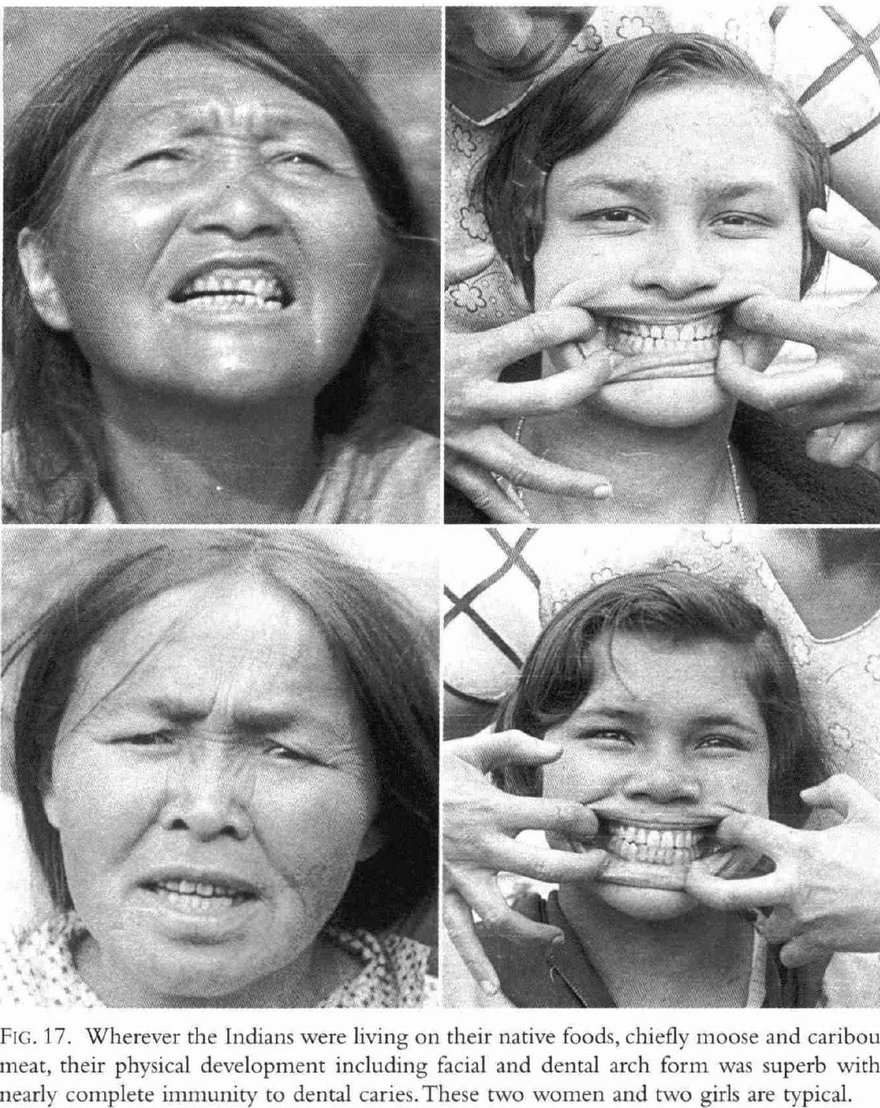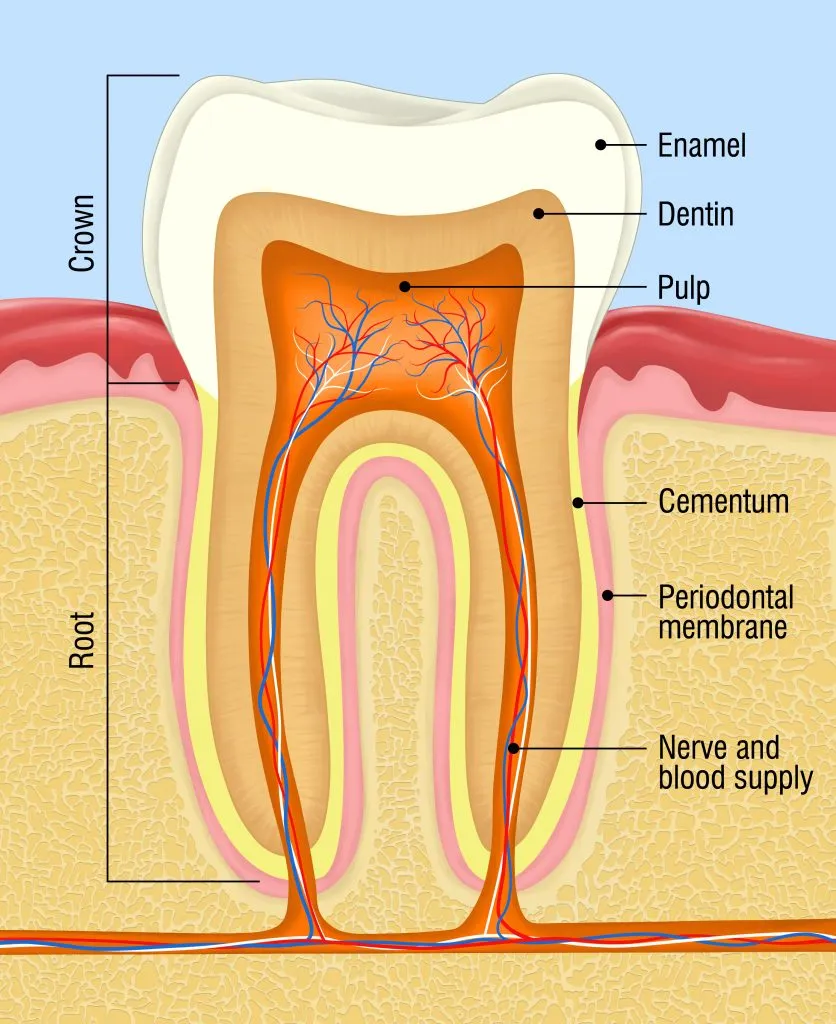Let’s start with the basics of tooth health and decay – your nutritional status, as proven by Weston A. Price about 100-years ago, when he spent years on remote locations living with different primitive tribes where he examined their nutritional status and health. He soon discovered that not only were they never sick, they also had perfect teeth with zero cavities among all the populace. Most of them consumed an almost 100% carnivorous diet of meat, organ meat, blood and milk.
Without enough minerals and trace elements, your teeth will lose density, become almost transparent and overly sensitive. This is commonly seen as it happens to all vegans, and especially fruitarians, within the first couple of years of adopting this agenda-driven and deadly way of eating. A plant-based diet is extremely deficient in all nutrients. Not only are many nutrients missing, those that are present are not bioavailable for humans and need to be converted.
As for directly ‘harming’ the teeth, carbohydrates, especially in the form of fructose and sucrose, is the biggest culprit. The sugars easily get stuck to the teeth and the bacteria trying to clean it up can hurt the enamel if the teeth and saliva production is compromised by nutrition deficiencies, which in turn allows for bacteria overgrowth and the lack of nutrients hinder the repair process of the enamel. However, this only explains a scenario with multiple cavities and general bad teeth health. It does not explain a single cavity with neighboring teeth unaffected. Tooth decay in this instance is a combination of sugars and nutrition deficiencies from a very bad diet (as seen in vegans and fruitarians.)
This also explains why some people who still consume a lot of carbohydrates (sugars) can have fairly good teeth — because they also consume enough animal products to fight off malnutrition, thus they have adequate saliva production, and their teeth can regenerate to keep up with the onslaught.
However, cavities can also be found in people who hardly eat any sweets or food with carbohydrates. Tooth decay also seems to be totally unrelated to dental care. People who are consistent with their dental hygiene also have cavities and the other way around. And if exposed to sugars and bacteria, why would one tooth get a cavity, but not the tooth next to it? You also have cavities that form on the inside of the tooth without any exposure to outside stressors. To explain these anomalies, we take a look at German New Medicine and how tooth decay, just like any other bodily problem, is connected to your psyche.
Anatomy of the tooth and why ‘root canals’ are insanity
Before we move on, we need a quick look at the anatomy of a tooth. To keep it simple, the visible part of a tooth above the gum line is called a crown and its outer layer is made of enamel. Below the gum line we have the root. On the inside, most of the tooth consist of dentin, a calcified structure that is denser than any bone, which allows for the withstanding of biting and grinding. In the middle of the tooth, we have the pulp, which extends down in the two roots of the tooth. The pulp contains blood vessels that nourish the tooth and nerves that provide sensitivity to heat, cold, pressure, and pain. The pulp cells are capable of producing new dentin to heal the tooth, providing you get the nutrients needed.
If you understand this, you should also see the absurdity of dentists performing ‘root canals.’ The root canal procedure involves removing the entire contents of the pulp and filling the inside of the tooth with a plastic material and toxic compounds such as arsenic. In other words, you are left with a completely dead and toxic tooth that now is incapable of repairing itself. If a tooth is so damaged that it cannot regenerate, it should be removed, not filled!
Dental health and the psyche – Biological Conflicts
In German New Medicine, we talk about biological conflicts. This occurs in the psyche as results of an unresolved mental trauma; and that conflict is connected to various parts of the body depending on what happened and the feelings associated with the event. This is identified with CT-scans and every symptom in thousands of patients has been linked to a specific localized ring-shaped formation in the brain. As for cavities, this ring would change a little bit depending on which tooth was affected and if the cavity was on the outside (enamel) or the inside (dentin) of the tooth.
The conflicts linked to different types of cavities
The biological conflict linked to the dentin in the tooth is simply the feeling of not being able to bite. This can be about food, as not being allowed to ‘bite,’ as in eat, certain things or being ‘forced’ by someone to eat less (as in losing weight.) It can also be in the sense of not being able, or allowing oneself, to “bite” or “snap back” at someone who hurt you.
If the cavity is on the outside, in the enamel, the conflict is with someone that is seen as bigger than you, or in a position above you, alike an ‘authority.’ This is often observed in children who feel emotionally hurt by something said or done by a parent, a teacher, or a bigger sibling or classmate (bully.) In adults it can be from a conflict with a ‘superior’ at work or with a government official (doctor, police officer, bank manager, etc.)
This is also why adults get more cavities on the inside, in the dentin, as this is from a conflict with someone who is smaller than you. This happen when you get upset or angry with someone but you cannot ‘bite back’ because the person is smaller and in a position that would make matters worse – as in ‘I’m not allowed to bite back,’ so instead you bite your tongue and hold it inside. This can be from being angry with your kids, your pet, or even your boss or colleague, especially if they are ‘weaker’ or ‘dumber’ than you but still holds a position of more power, so it’s inappropriate to ‘show your teeth’ or ‘bite back’ at them and put them in their place. Instead, you take it, and the irritation, frustration, and anger build up on the inside.
The conflict phase – break-down and cell loss
While these conflicts go on unresolved, cell loss occur in a tooth associated with the type of conflict and depending on whom it is with. Variables such as how bad the conflict is, the emotions involved, and for how long it goes on, will determine the size and severity of the cavity. If it’s on the outside, you might notice it in a mirror or when visiting a dentist. If it’s on the inside, you will not feel or notice it until the cavity is so big that the integrity of the tooth is compromised and it breaks. Yes, there is no real pain or discomfort while the tooth is breaking down during the conflict phase.
And simply going to a dentist to fill the cavity will not solve the conflict. New cavities will form, and if you kill the tooth by a root canal, other teeth will start to get affected instead.
Resolved conflict – symptoms and the healing and repair phase
Some of these conflicts will temporarily or permanently resolve themselves without us even realizing it as we patch up the relationship with the offender. Or perhaps a kid in conflict with a teacher or a bully comes to the end of a school year and enter summer and it’s temporarily forgotten about because of all the fun you get into with your friends and being away from school.
This is when the healing begins. The biological program switches as it helps us to adapt to these stressful situations. In a bite conflict that has been resolved, our body now wants to make that tooth stronger so we can ‘bite back’ if it happens again. If the cavity is on the outside, you might not notice much as it will slowly fill itself. However, if it’s on the inside, the healing process causes inflammation and edema which can push against the nerves and cause tooth ache. There will also be beneficial bacteria helping with the process, as well as puss developing as old damaged and dead cells are removed. So, when you feel pain in a tooth and it’s inflamed, it’s not from breaking down, it’s actually from healing.
So, as you can see, going to a dentist because of pain and getting a treatment is very backwards. The only time a dentist would be needed is if you go with a conflict for so long that a tooth breaks, it can no longer repair itself, and you need to pull it out.
Identifying and resolving the conflict
Now, if you have a tooth ache, the important thing here is to understand the reason behind the conflict and what you resolved. Otherwise, it will surely happen again, and you will go back and forth, always having problems with the same tooth or teeth. In other words, you enter a conflict and the tooth starts to break down, then you temporarily solve it and it starts to heal and you experience some pain and discomfort, then you get into the same conflict again, the pain goes a way as the healing is stopped and the tooth starts to break down again – and then it repeats all over. It’s a vicious cycle.
If you have a cavity on the outside that you can see, or if you just started to experience pain from healing, you need to identify the conflict involved. What conflict is causing it and with whom? You need to acknowledge it, accept it, come to peace with it, and work on it so it doesn’t bother you or happen again. This is true for most symptoms or ‘diseases’ that is caused by biological conflicts, as we have discussed in previous articles.
As for tooth ache, it’s a sign of healing, and you’ll have to tough it out, or use some natural painkillers to mitigate the pain. To help with the healing and speed it up, make sure to consume a lot of liver, egg yolks, meat, bone broth, and if available, raw milk. These are the beast sources of the vitamins (A, D, E, K2) needed for healing to take place and for the minerals and amino acids needed for constructing new enamel and/or dentin.
So, to summarize, to heal a cavity, you identify your biological conflict, you come to peace with it, you manage the symptoms, and you give your body the nutrients needed to heal and repair.

